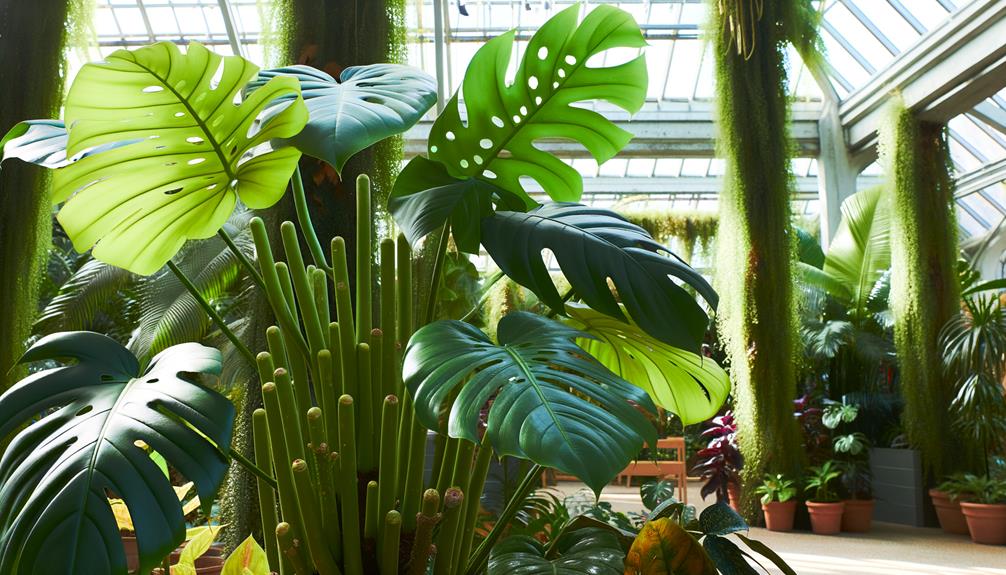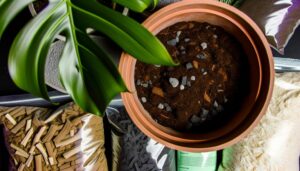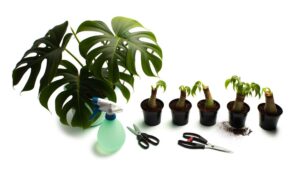Monstera Standleyana Growth Rate
The Monstera standleyana boasts a rapid growth rate, typically unfurling new leaves every 2-4 weeks under ideal conditions. Its elongated, lanceolate leaves reach up to 20 cm in length and enhance its climbing habit, aided by aerial roots.
To maximize growth, maintain bright, indirect light and 70%-90% humidity, providing a well-draining soil with a pH around 5.5-6.5. Regular watering, avoiding cold drafts, and bi-monthly fertilization with a balanced N-P-K ratio of 20-20-20 sustain vigorous growth.
For more advanced care techniques and troubleshooting tips, consider exploring further details.

Key Takeaways
- Monstera Standleyana has a rapid growth rate, with new leaves unfurling every 2-4 weeks.
- Ideal growth conditions include bright, indirect light, high humidity, and well-draining soil.
- Humidity between 70% and 90% significantly boosts growth rates and overall plant health.
- Balanced fertilization every 4-6 weeks supports vigorous growth and leaf development.
- Seasonal variations affect growth, with accelerated growth in spring and summer and slower growth in fall and winter.
Understanding Monstera Standleyana
Often acknowledged for its distinctive foliage, Monstera Standleyana boasts unique growth characteristics that are crucial for any plant biologist or enthusiast to comprehend. You'll find its elongated, lanceolate leaves adorned with variegated patterns. These leaves can reach lengths of up to 20 cm.
When assessing its growth rate, focus on the internodal spacing and the development of aerial roots. Monstera Standleyana exhibits a climbing growth habit facilitated by these aerial roots, which latch onto supports. It prefers indirect sunlight and high humidity, both of which impact its growth speed significantly.
Regularly monitor the soil moisture levels to ensure prime growth conditions. By understanding these metrics, you can cultivate a flourishing Monstera Standleyana that showcases its full potential.
Natural Habitat and Origins
Monstera Standleyana originates from the tropical rainforests of Central and South America, where it thrives in the understory with ample humidity and indirect sunlight.
In its native habitat, this climbing epiphyte relies on tree trunks for support, allowing it to reach heights of up to 10-20 feet. The dense canopy above filters light, creating the dappled shade essential for its photosynthetic efficiency.
Humidity levels typically range from 70% to 90%, fostering ideal stomatal function and transpiration rates. Soil composition is rich in organic matter, promoting robust root development and nutrient uptake.
These environmental conditions enable Monstera Standleyana to exhibit a rapid growth rate, with new leaves unfurling approximately every 2-4 weeks during the growing season.
Ideal Growing Conditions
To optimize the growth rate of Monstera Standleyana, make sure it receives bright, indirect light and maintains a consistent humidity level between 70% and 90%. Confirm the soil is well-draining, rich in organic matter, and slightly acidic, with a pH range of 5.5 to 6.5.
Regularly water the plant, keeping the soil evenly moist but not waterlogged to avoid root rot. Ideal temperatures should remain between 65°F and 85°F, avoiding cold drafts and sudden temperature fluctuations.
Fertilize bi-monthly during the growing season with a balanced, water-soluble fertilizer. Pruning older leaves and providing a moss pole or trellis will support vertical growth, enhancing the plant's structural integrity and leaf size.
Monitoring these conditions will maximize your Monstera Standleyana's growth metrics.
Light Requirements
You'll find that Monstera Standleyana thrives under bright, indirect light, which maximizes photosynthetic efficiency and promotes robust growth.
In conditions of insufficient light, you may notice a significant reduction in growth rate and leaf variegation.
Monitoring light intensity with a PAR meter guarantees you maintain peak illumination levels for sustained plant health.
Optimal Sunlight Conditions
Ensuring your Monstera Standleyana receives medium to bright indirect light is essential for best photosynthesis and robust growth. This tropical plant thrives under filtered sunlight, which maximizes chlorophyll production and enhances foliage development. Aim for placing your Monstera near north or east-facing windows, where it can absorb ample light without direct sun exposure that may scorch its leaves.
| Light Intensity | Duration (Hours/Day) |
|---|---|
| Medium Indirect | 6-8 |
| Bright Indirect | 8-10 |
| Filtered Light | 10-12 |
| Full Shade | Not Recommended |
| Direct Sunlight | Not Recommended |
Effects of Low Light
However, insufficient light can significantly impede the Monstera Standleyana's growth rate, leading to elongated, weak stems and smaller, less vibrant leaves. Photosynthesis efficiency drops, causing subpar energy production.
You'll notice:
- Stem Elongation: The plant's internodes stretch as it reaches for more light, resulting in spindly growth.
- Leaf Diminishment: Leaves become undersized and lose their characteristic variegation, impacting overall aesthetic.
- Reduced Vigor: Growth metrics show a slower rate of new leaf production and root development.
- Chlorosis: Inadequate light may trigger chlorosis, where leaves turn yellow due to insufficient chlorophyll synthesis.
Ensuring ideal light conditions is crucial to maintaining Monstera Standleyana's health and strong growth metrics. Don't underestimate the significance of proper lighting.
Soil Preferences
To maximize Monstera standleyana's growth rate, select a well-draining soil mix that maintains moisture without becoming waterlogged. Aim for a substrate containing components like perlite, peat moss, and orchid bark. This combination enhances aeration, root oxygenation, and efficient nutrient uptake.
Proper soil pH should range between 5.5 and 7.0, which facilitates nutrient availability. Using a soil moisture meter can help monitor the moisture levels accurately, ensuring they remain in the ideal range.
Avoid compacted soils, as they impede root expansion and gas exchange, reducing overall growth rates. By prioritizing a balanced soil composition, you'll create an ideal environment for your Monstera standleyana to thrive, contributing significantly to its robust growth metrics and overall plant health.
Watering Needs
Proper watering is essential for maximizing Monstera standleyana's growth rate, as it directly influences root health and nutrient absorption. You should monitor soil moisture levels closely and adjust your watering schedule accordingly.
Here are key steps to achieve optimal hydration:
- Check Soil Moisture: Use a moisture meter to measure the soil's dampness. The top 1-2 inches should be dry before watering.
- Water Quantity: Make sure to water thoroughly until excess water drains from the bottom of the pot, ensuring deep root saturation.
- Frequency: Typically, water every 1-2 weeks, adjusting based on environmental conditions and plant size.
- Drainage: Ensure your pot has sufficient drainage to prevent waterlogging, which can lead to root rot and stunted growth.
Humidity Levels
To optimize Monstera Standleyana's growth rate, you should maintain humidity levels between 60% and 80%. High humidity boosts cellular turgor pressure, enhancing overall growth metrics.
Conversely, low humidity can hinder stomatal function, slowing down photosynthesis and growth.
Optimal Humidity Range
Maintaining a humidity level between 60% and 80% is necessary for the ideal growth of Monstera Standleyana. This plant thrives in environments that mimic its native tropical habitat. Consistent humidity supports best transpiration rates and nutrient uptake.
To achieve the most favorable humidity conditions, you should:
- Use a humidifier: A humidifier helps maintain a stable humidity level, essential for Monstera Standleyana.
- Mist regularly: Light misting can temporarily boost humidity around the plant.
- Group plants together: Plants naturally release moisture, creating a micro-humid environment.
- Place near water sources: Positioning the plant near water sources like aquariums can increase ambient humidity.
Humidity Impact on Growth
High moisture levels directly influence the Monstera Standleyana's growth rate by optimizing stomatal function and enhancing nutrient absorption efficiency. When humidity is high, the stomata, small openings on the leaves, remain open longer, facilitating gas exchange vital for photosynthesis. This process maximizes carbon dioxide intake while minimizing water loss, promoting healthy growth.
Additionally, higher moisture levels improve nutrient uptake by maintaining ideal leaf turgor pressure. You should aim for moisture levels between 60-80% to guarantee vigorous growth. Monitoring and adjusting moisture can significantly impact growth metrics such as leaf size, internodal length, and overall biomass.
Use a hygrometer to track humidity and employ humidifiers or pebble trays to maintain the ideal environment for your Monstera Standleyana.
Fertilization Tips
Applying a balanced, slow-release fertilizer every 4-6 weeks guarantees that your Monstera Standleyana receives the essential nutrients for best growth. This process provides steady nutrient availability, promoting ideal photosynthesis and robust cellular development.
Here are some fertilization tips to keep in mind:
- Nutrient Ratio: Choose a fertilizer with an N-P-K (nitrogen-phosphorus-potassium) ratio of 20-20-20 to provide balanced nutrition.
- Application Method: Apply the fertilizer to the soil surface, ensuring even distribution to avoid nutrient burn.
- Watering: Water thoroughly after fertilizing to facilitate nutrient absorption into the root system.
- Seasonal Adjustments: Reduce fertilization frequency during winter months when the plant's growth rate naturally slows down.
Pruning Techniques
Proper pruning techniques are essential for managing your Monstera Standleyana's growth rate.
You'll want to focus on the timing for pruning, the right tools and materials, and methods to encourage new growth.
Timing for Pruning
Pruning your Monstera Standleyana during late spring or early summer optimizes growth by aligning with its peak growing season. By targeting this period, you enhance the plant's photosynthetic efficiency and nutrient uptake.
To guarantee successful pruning, follow these steps:
- Identify Nodes: Locate the plant nodes where leaves and roots emerge. Prune just above these points to stimulate new growth.
- Remove Dead Foliage: Cut away any yellowing or dead leaves to prevent disease and improve light penetration.
- Thin Out Crowded Areas: Trim densely packed sections to increase air circulation and reduce competition for resources.
- Encourage Lateral Growth: Prune vertical stems to promote bushier, more compact growth, enhancing overall plant vigor.
Proper timing and technique secure your Monstera Standleyana thrives.
Tools and Materials
To safeguard precise and effective trimming of your Monstera Standleyana, equip yourself with sterilized, sharp trimming shears and gloves to minimize plant stress and prevent infection. Sharp shears guarantee clean cuts, reducing damage to cellular structures and promoting rapid healing. Sterilization, using isopropyl alcohol or a bleach solution, prevents pathogen transmission that can compromise plant health. Wearing gloves safeguards your hands from sap and potential irritants.
When trimming, target nodes and internodes where growth metrics indicate congestion or unhealthy foliage. Remove any yellowing or damaged leaves, as these can divert resources from healthy growth. Employ a systematic approach, ensuring cuts are at a 45-degree angle to prevent water accumulation, which can lead to rot. Proper tools and techniques optimize Monstera Standleyana's growth rate.
Encouraging New Growth
Effective pruning techniques are essential for stimulating new growth in your Monstera Standleyana, ensuring ideal resource allocation and robust development. By strategically removing specific parts of the plant, you can enhance photosynthetic efficiency and nutrient distribution.
Follow these steps:
- Identify Nodes: Locate the nodes where leaves and aerial roots emerge; these are the growth points.
- Sterilize Tools: Use sterilized pruning shears to prevent infections.
- Cut Above Nodes: Make precise cuts just above a node to encourage branching.
- Remove Damaged Leaves: Eliminate any yellowing or damaged leaves to direct resources to healthier parts.
Common Growth Patterns
Monstera standleyana typically displays a vining growth habit, with internodal length and leaf size directly influenced by light availability and nutrient levels.
You'll notice that in ideal lighting conditions, internodes become shorter, producing more compact foliage. Conversely, insufficient light elongates internodes, resulting in a more stretched appearance.
Nutrient availability also plays a crucial role. Sufficient nitrogen promotes lush, green leaves, while phosphorus and potassium support root and shoot development. When adequately supported, the plant will climb structures, showcasing its unique variegated leaves prominently.
Pruning can encourage denser growth, as it stimulates axillary bud development. Regular observations of these growth metrics will help you maintain the desired aesthetic and health of your Monstera standleyana. Understanding these patterns helps you optimize its growth potential.
Seasonal Growth Variations
Environmental conditions, such as temperature and daylight duration, greatly influence Monstera standleyana's growth rate throughout the year. You'll observe significant variations in its growth patterns across different seasons.
During the spring and summer months, the plant experiences accelerated growth due to ideal light and warm temperatures. Conversely, in fall and winter, growth slows as environmental conditions become less favorable.
To enhance growth, you should:
- Increase light exposure: Ensure your plant gets around 12-14 hours of indirect sunlight daily.
- Maintain temperature: Keep ambient temperatures between 65-85°F (18-29°C).
- Provide humidity: Aim for 60-80% humidity levels.
- Adjust watering: Increase watering frequency during the growing season and reduce it in winter.
Understanding these factors will help you maximize your Monstera standleyana's growth potential.
Troubleshooting Slow Growth
Identifying the root cause of your Monstera standleyana's slow growth requires a systematic evaluation of its environmental conditions, nutrient availability, and potential pest infestations.
First, assess light levels; insufficient light can hinder photosynthesis, reducing growth rates. Guarantee the plant receives bright, indirect light.
Next, examine the soil's nutrient profile. A deficiency in essential elements like nitrogen, phosphorus, or potassium can stunt development. Regularly apply a balanced, water-soluble fertilizer to remedy this.
Additionally, inspect for pests such as spider mites or aphids, which can sap crucial nutrients and impede growth. Utilize appropriate insecticidal treatments if needed.
Conclusion
In nurturing your Monstera standleyana, think of it as cultivating a relationship with a reliable companion. With the right light, soil, and care, it'll reward you with abundant growth, symbolizing a flourishing partnership.
Monitor its growth metrics like leaf size and node spacing, and adjust conditions as needed. If growth slows, it's a call for attention and care.
Your plant's vigor is a proof of your dedication, reflecting the harmony between your efforts and nature's resilience.






